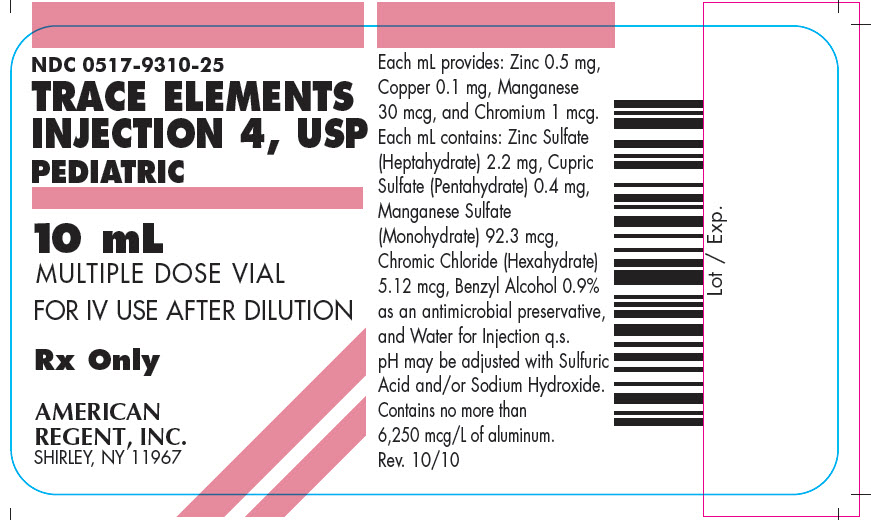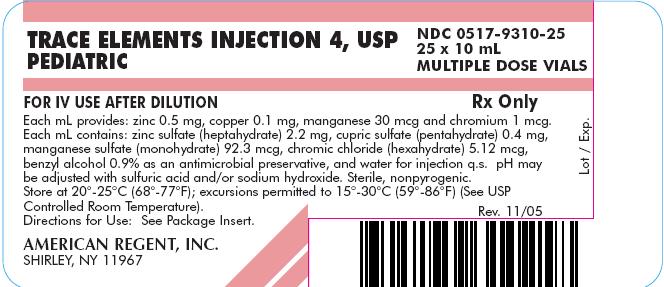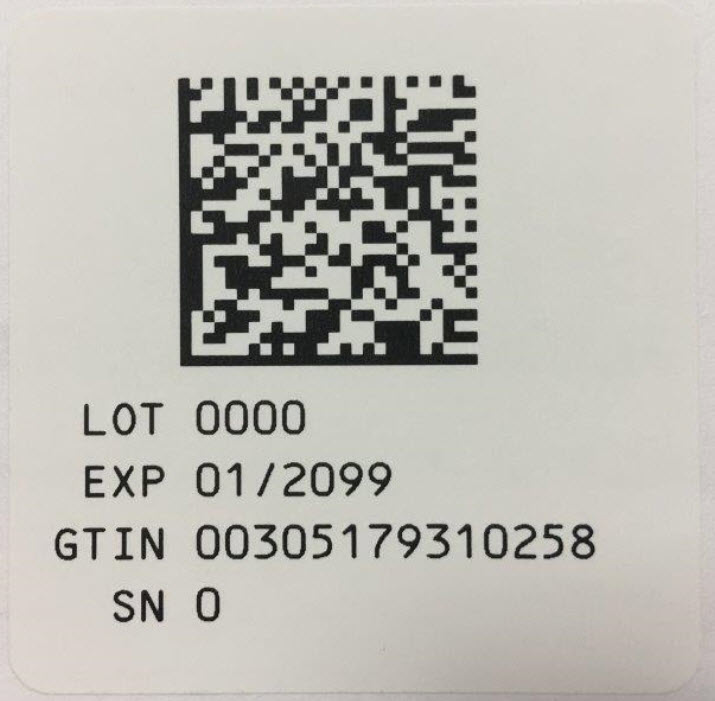TRACE ELEMENTS 4 injection, solution
Trace Elements 4 by
Drug Labeling and Warnings
Trace Elements 4 by is a Prescription medication manufactured, distributed, or labeled by American Regent, Inc., Luitpold Pharmaceuticals, Inc.. Drug facts, warnings, and ingredients follow.
Drug Details [pdf]
- SPL UNCLASSIFIED SECTION
-
DESCRIPTION
TRACE ELEMENTS INJECTION 4, USP PEDIATRIC is a sterile, nonpyrogenic solution containing four Trace Elements for use as an additive for Total Parenteral Nutrition (TPN).
Each mL provides: Zinc 0.5 mg, Copper 0.1 mg, Manganese 30 mcg, and Chromium 1 mcg. Each mL contains: Zinc Sulfate Heptahydrate 2.2 mg (equivalent to 0.5 mg Zinc), Cupric Sulfate Pentahydrate 0.4 mg (equivalent to 0.1 mg Copper), Manganese Sulfate Monohydrate 92.3 mcg (equivalent to 30 mcg Manganese), Chromic Chloride Hexahydrate 5.12 mcg (equivalent to 1 mcg Chromium), and Water for Injection q.s. pH may be adjusted with Sulfuric Acid and/or Sodium Hydroxide. 0.9% Benzyl Alcohol is added as an antimicrobial preservative.
-
CLINICAL PHARMACOLOGY
ZINC has been identified as a cofactor for over 70 different enzymes, including carbonic anhydrase, alkaline phosphatase, lactic dehydrogenase and both RNA and DNA polymerase. Zinc facilitates wound healing, helps maintain normal growth rates, normal skin hydration and senses of taste and smell.
Providing zinc during TPN prevents development of the following deficiency symptoms: Parakeratosis, hypogeusia, anorexia, dysosmia, geophagia, hypogonadism, growth retardation and hepatosplenomegaly. At plasma levels below 20 mcg zinc/100 mL, dermatitis followed by alopecia has been reported for TPN patients.
COPPER is essential as a cofactor for serum ceruloplasmin, an oxidase necessary for proper formation of the iron carrier protein, transferrin. Copper also helps maintain normal rates of red and white blood cell formation. Scorbutic type bone changes seen in infants fed exclusively with copper-poor cow’s milk are believed due to decreased activity of ascorbate oxidase, a cuproenzyme.
Providing copper during TPN prevents development of the following deficiency symptoms: leukopenia, neutropenia, anemia, depressed ceruloplasmin levels, impaired transferring formation and secondary iron deficiency.
MANGANESE is an activator for enzymes such as polysaccharide polymerase, liver arginase, cholinesterase and pyruvate carboxylase.
Providing manganese during TPN prevents development of the following deficiency symptoms: nausea and vomiting, weight loss, dermatitis, and changes in growth and color of hair.
CHROMIUM (trivalent) is part of glucose tolerance factor, an activator of insulin-mediated reactions. Chromium helps to maintain normal glucose metabolism and peripheral nerve function.
Providing chromium during TPN prevents development of the following deficiency symptoms: impaired glucose tolerance, ataxia, peripheral neuropathy, and a confusional state similar to mild/moderate hepatic encephalopathy.
-
INDICATIONS AND USAGE
This formulation is indicated for use as a supplement to intravenous solutions given for TPN for children up to 11 years of age. Administration of the solution in TPN solutions helps to maintain plasma levels of zinc, copper, manganese, and chromium and to prevent depletion of endogenous stores of these trace elements and subsequent deficiency symptoms.
- CONTRAINDICATIONS
-
WARNINGS
Copper and Manganese are eliminated via the bile. In patients with severe liver dysfunction and/or biliary tract obstruction, decreasing or omitting copper and manganese supplements entirely may be necessary.
This product contains aluminum that may be toxic. Aluminum may reach toxic levels with prolonged parenteral administration if kidney function is impaired. Premature neonates are particularly at risk because their kidneys are immature, and they require large amounts of calcium and phosphate solutions, which contain aluminum.
Research indicates that patients with impaired kidney function, including premature neonates, who receive parenteral levels of aluminum at greater than 4 to 5 mcg/kg/day accumulate aluminum at levels associated with central nervous system and bone toxicity. Tissue loading may occur at even lower rates of administration.
-
PRECAUTIONS
Before administering TRACE ELEMENTS INJECTION 4, USP PEDIATRIC in TPN solutions, the physician must assess the metabolic requirements for trace elements and disease state of the patient. Frequent determinations of serum levels of the various trace elements are suggested as a guideline for adjusting the dosage or completely omitting the solution. ZINC is eliminated via the intestine and kidneys. The possibility of retention should be considered in patients with malfunctioning excretory routes. COPPER and MANGANESE are eliminated via the bile, therefore, the possibility of the retention of these elements should be considered in patients with biliary obstruction. Ancillary routes of MANGANESE excretion, however, include pancreatic juice, or reabsorption into the lumen of duodenum, jejunum, or ileum.
In assessing the contribution of CHROMIUM supplements to maintenance of normal glucose homeostasis, consideration should be given to the possibility that the patient may be diabetic, in which case oral or intravenous antidiabetic medication may be indicated.
- ADVERSE REACTIONS
-
OVERDOSAGE
Symptoms of ZINC overdose resulting from oral ingestion of Zinc Sulfate in large amounts have resulted in death. Symptoms included nausea, vomiting, dehydration, electrolyte imbalances, dizziness, abdominal pain, lethargy and incoordination. Single intravenous doses of 1 to 2 mg zinc/kg body weight have been given to adult leukemia patients without toxic manifestations. Normal plasma levels for Zinc vary from approximately 88 to 112 mcg/100 mL. Plasma levels sufficient to produce symptoms of toxic manifestations are not known. Calcium supplements may confer a protective effect against Zinc toxicity.
Symptoms of COPPER toxicity reported in literature include prostration, behavior change, diarrhea, progressive marasmus, hypotonia, photophobia and peripheral edema; such symptoms have been reported with a serum copper level of 286 mcg/dL. D-penicillamine has been reported effective as an antidote.
MANGANESE toxicity has not been reported in patients receiving TPN. Neither have reports of manganese toxicity from excessive intake in foods and/or beverages been published. Symptoms of CHROMIUM toxicity include nausea, vomiting, ulcers and gastrointestinal tract, renal and hepatic damage and abnormalities of the central nervous system culminating in convulsions and coma. Trivalent Chromium administered intravenously to TPN patients has been shown to be nontoxic when given at dosage levels up to 250 mcg/day for two consecutive weeks.
-
DOSAGE AND ADMINISTRATION
Do not use syringes, needles, or intravenous sets containing aluminum parts that may come in contact with TRACE ELEMENTS INJECTION 4, USP PEDIATRIC, for preparation or administration. Aluminum reacts and dissolves in acid media.
Each mL of the solution provides Zinc 0.5 mg, Copper 0.1 mg, Manganese 30 mcg, and Chromium 1 mcg, and is administered intravenously only after dilution to a minimum of 1:200. The suggested dosage ranges for the four trace elements are:
ZINC: For the metabolically stable adult receiving TPN, the suggested intravenous dosage level is 2.5 to 4 mg zinc/day. An additional 2 mg zinc/day is suggested for acute catabolic states. For the stable adult with fluid loss from the small bowel, an additional 12.2 mg zinc/liter of small bowel fluid lost, or an additional 17.1 mg zinc/kg of stool or ileostomy output is recommended. Frequent monitoring of zinc blood levels is suggested for patients receiving more than the usual maintenance dosage level of zinc. Normal plasma levels for zinc vary from approximately 88 to 112 mcg/100 mL.
For full term infants and children, 100 mcg zinc/kg/day is recommended. For premature infants (birth weight less than 1500 g) up to 3 kg in body weight, 300 mcg zinc/kg/day is suggested.
COPPER: For the metabolically stable adult receiving TPN, the suggested additive dosage level is 0.5 to 1.5 mg copper/day. For pediatric patients, the suggested additive dosage level is 20 mcg copper/kg/day. The normal plasma range for copper is approximately 80 to 160 mcg/100 mL.
MANGANESE: For the metabolically stable adult receiving TPN, the suggested additive dosage level for manganese is 0.15 to 0.8 mg/day. For pediatric patients, a dosage level of 2 to 10 mcg manganese/kg/day is recommended.
CHROMIUM: For the metabolically stable adult receiving TPN, the suggested additive dosage level is 10 to 15 mcg chromium/day. The metabolically stable adult with intestinal fluid loss may require 20 mcg chromium/day with frequent monitoring of blood levels as a guideline for subsequent administration. For pediatric patients, the suggested additive dosage level is 0.14 to 0.20 mcg/kg/day.
Periodic monitoring of plasma levels of Zinc, Copper, Manganese, and Chromium is suggested as a guideline for administration.
Aseptic addition of TRACE ELEMENTS® - 4 to parenteral nutrition solutions under a laminar flow hood is recommended. The trace elements present in TRACE ELEMENTS® - 4 are physically compatible with the electrolytes and vitamins usually present in parenteral nutrition formulations.
Do not directly mix ascorbic acid injection with copper or selenium containing parenteral products in the same syringe or vial, as this admixture may cause the formation of an insoluble precipitate.
Parenteral drug products should be inspected visually for particulate matter and discoloration prior to administration, whenever solution and container permit.
Store at 20° to 25°C (68° to 77°F); excursions permitted to 15° to 30°C (59° to 86°F) (See USP Controlled Room Temperature).
-
HOW SUPPLIED
TRACE ELEMENTS INJECTION 4, USP PEDIATRIC
Each mL provides: Zinc 0.5 mg, Copper 0.1 mg, Manganese 30 mcg, and Chromium 1 mcg.
NDC: 0517-9310-25 10 mL Multiple Dose Vial* Packaged in boxes of 25
*Contains 0.9% Benzyl Alcohol as an antimicrobial preservative.
AMERICAN
REGENT, INC.
SHIRLEY, NY 11967IN9310
Rev. 8/18 -
PACKAGE LABEL.PRINCIPAL DISPLAY PANEL
Container
NDC: 0517-9310-25
TRACE ELEMENTS INJECTION 4, USP
PEDIATRIC10 mL
MULTIPLE DOSE VIALFOR IV USE AFTER DILUTION
Rx Only
AMERICAN
REGENT, INC.
SHIRLEY, NY 11967
CartonTRACE ELEMENTS INJECTION 4, USP
PEDIATRICNDC: 0517-9310-25
25 x 10 mL
MULTIPLE DOSE VIALSFOR IV USE AFTER DILUTION
Rx Only
Each mL provides: zinc 0.5 mg, copper 0.1 mg, manganese 30 mcg, and chromium 1 mcg. Each mL contains: zinc Sulfate (heptahydrate) 2.2 mg, cupric sulfate (pentahydrate) 0.4 mg, manganese sulfate (monohydrate) 92.3 mcg, chromic chloride (hexahydrate) 5.12 mcg, benzyl alcohol 0.9% as an antimicrobial preservative, and water for injection q.s. pH may be adjusted with sulfuric acid and/or sodium hydroxide. Sterile, nonpyrogenic.
Store at 20°-25°C (68°-77°F); excursions permitted to 15°-30°C (59°-86°F) (See USP Controlled room Temperature).
Directions for Use: See Package Insert.AMERICAN REGENT, INC.
SHIRLEY, NY 11967Rev 11/05

- Serialization Label
-
INGREDIENTS AND APPEARANCE
TRACE ELEMENTS 4
trace elements 4 injection, solutionProduct Information Product Type HUMAN PRESCRIPTION DRUG Item Code (Source) NDC: 0517-9310 Route of Administration INTRAVENOUS Active Ingredient/Active Moiety Ingredient Name Basis of Strength Strength ZINC SULFATE HEPTAHYDRATE (UNII: N57JI2K7WP) (ZINC CATION - UNII:13S1S8SF37) ZINC CATION 2.2 mg in 1 mL CUPRIC SULFATE (UNII: LRX7AJ16DT) (CUPRIC CATION - UNII:8CBV67279L) CUPRIC CATION 0.4 mg in 1 mL MANGANESE SULFATE (UNII: W00LYS4T26) (MANGANESE CATION (2+) - UNII:H6EP7W5457) MANGANESE CATION (2+) 92.3 ug in 1 mL CHROMIC CHLORIDE (UNII: KB1PCR9DMW) (CHROMIC CATION - UNII:X1N4508KF1) CHROMIC CATION 5.12 ug in 1 mL Inactive Ingredients Ingredient Name Strength BENZYL ALCOHOL (UNII: LKG8494WBH) SODIUM HYDROXIDE (UNII: 55X04QC32I) SULFURIC ACID (UNII: O40UQP6WCF) WATER (UNII: 059QF0KO0R) Packaging # Item Code Package Description Marketing Start Date Marketing End Date 1 NDC: 0517-9310-25 25 in 1 TRAY 02/24/1994 1 10 mL in 1 VIAL, MULTI-DOSE; Type 0: Not a Combination Product Marketing Information Marketing Category Application Number or Monograph Citation Marketing Start Date Marketing End Date UNAPPROVED DRUG OTHER 02/24/1994 Labeler - American Regent, Inc. (002033710) Establishment Name Address ID/FEI Business Operations American Regent, Inc. 002033710 ANALYSIS(0517-9310) , MANUFACTURE(0517-9310)
© 2025 FDA.report
This site is not affiliated with or endorsed by the FDA.
